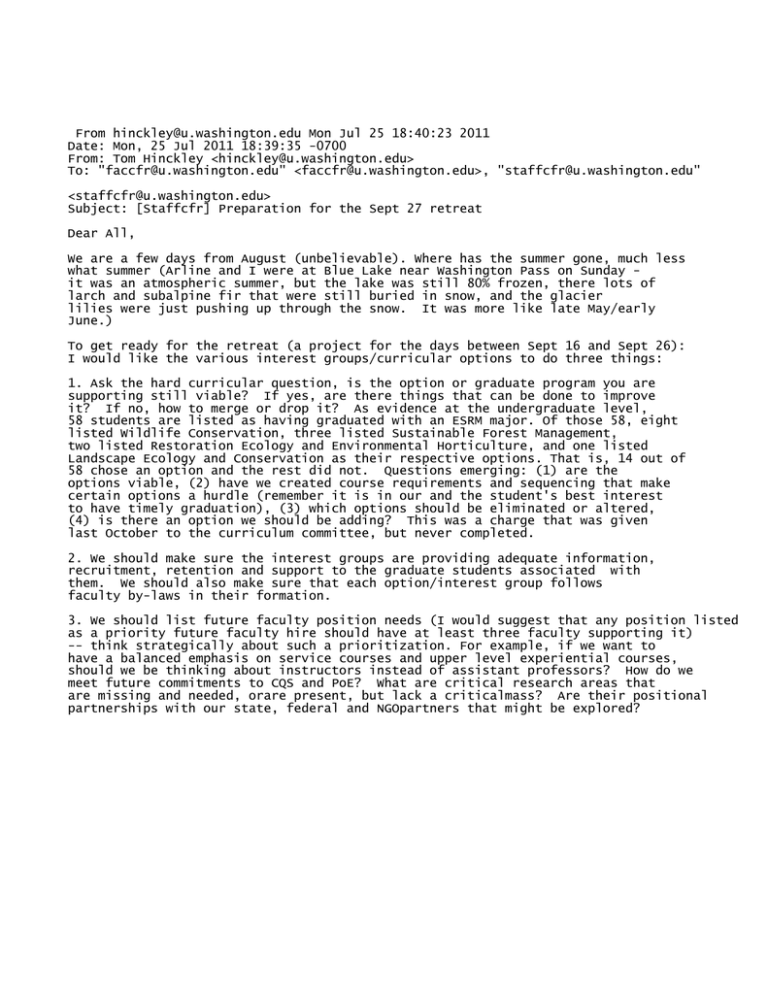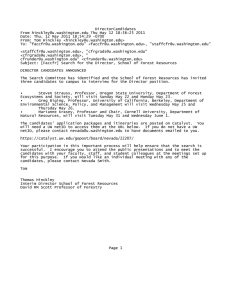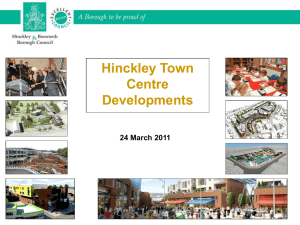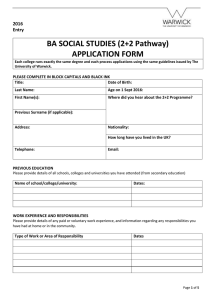From Mon Jul 25 18:40:23 2011 From: Tom Hinckley <>
advertisement

From hinckley@u.washington.edu Mon Jul 25 18:40:23 2011 Date: Mon, 25 Jul 2011 18:39:35 -0700 From: Tom Hinckley <hinckley@u.washington.edu> To: "faccfr@u.washington.edu" <faccfr@u.washington.edu>, "staffcfr@u.washington.edu" <staffcfr@u.washington.edu> Subject: [Staffcfr] Preparation for the Sept 27 retreat Dear All, We are a few days from August (unbelievable). Where has the summer gone, much less what summer (Arline and I were at Blue Lake near Washington Pass on Sunday it was an atmospheric summer, but the lake was still 80% frozen, there lots of larch and subalpine fir that were still buried in snow, and the glacier lilies were just pushing up through the snow. It was more like late May/early June.) To get ready for the retreat (a project for the days between Sept 16 and Sept 26): I would like the various interest groups/curricular options to do three things: 1. Ask the hard curricular question, is the option or graduate program you are supporting still viable? If yes, are there things that can be done to improve it? If no, how to merge or drop it? As evidence at the undergraduate level, 58 students are listed as having graduated with an ESRM major. Of those 58, eight listed Wildlife Conservation, three listed Sustainable Forest Management, two listed Restoration Ecology and Environmental Horticulture, and one listed Landscape Ecology and Conservation as their respective options. That is, 14 out of 58 chose an option and the rest did not. Questions emerging: (1) are the options viable, (2) have we created course requirements and sequencing that make certain options a hurdle (remember it is in our and the student's best interest to have timely graduation), (3) which options should be eliminated or altered, (4) is there an option we should be adding? This was a charge that was given last October to the curriculum committee, but never completed. 2. We should make sure the interest groups are providing adequate information, recruitment, retention and support to the graduate students associated with them. We should also make sure that each option/interest group follows faculty by-laws in their formation. 3. We should list future faculty position needs (I would suggest that any position listed as a priority future faculty hire should have at least three faculty supporting it) -- think strategically about such a prioritization. For example, if we want to have a balanced emphasis on service courses and upper level experiential courses, should we be thinking about instructors instead of assistant professors? How do we meet future commitments to CQS and PoE? What are critical research areas that are missing and needed, orare present, but lack a criticalmass? Are their positional partnerships with our state, federal and NGOpartners that might be explored? Retreat Preparation 2011 All faculty and staff should think about how we prioritize both instructional as well as research needs. Programs need coherence. For example, research associates and research staff scientists need to be connected to a tenure-track faculty member'sresearch program. Islands of singular, non-tenure track activity are not likely to be supported in the future -- tenure track faculty need to reach out and others will need to find programmatic homes. We lso need to think about existing gaps or oon to emerge gapsin expertise within a programs that will sneed filling. I am hoping that by early October we can be moving forward either with a plan of action or a specific charge to an appropriate committee. I hoping that between now and September 16, you as an individual will give thought to these questions/issues and perhaps begin some email or hallway or field-based discussion. September 27th will be an important date where we examine the various transitions we are faced with and how best to meet them. Thank you. Tom Thomas Hinckley Interim Director School of Forest Resources David RM Scott Professor of Forestry Page 2



